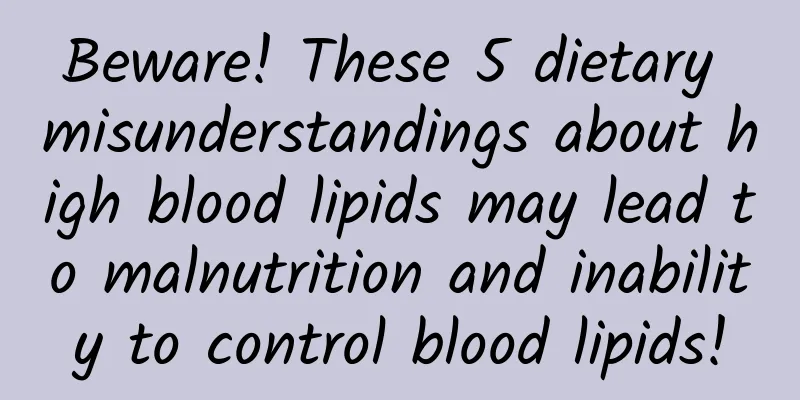Beware! These 5 dietary misunderstandings about high blood lipids may lead to malnutrition and inability to control blood lipids!

|
There are more and more patients with hyperlipidemia. According to the "Report on the Nutrition and Chronic Disease Status of Chinese Residents (2020)", the overall prevalence of hyperlipidemia among residents aged 18 and above in my country is as high as 35.6%. In the first-tier cities where I live, the proportion of adult males with abnormal blood lipids is even as high as more than 40%. What are the dangers of high blood lipids? There is more than one type of "fat" in high blood lipids, including triglycerides and cholesterol. Clinically, the following four conditions are all considered high blood lipids: However, elevated levels of LDL cholesterol (“bad cholesterol”) are the risk factor to watch out for the most. High blood lipids do not seem to have many symptoms in normal times, but in the long run, low-density lipoprotein cholesterol (LDL-C) can easily form plaques on the walls of coronary arteries and other arteries, causing the arteries to become increasingly narrow and restricting blood flow. If the plaque ruptures, it may cause a stroke or heart attack. Meta-analysis shows that there is a linear relationship between high serum cholesterol levels and cardiovascular disease mortality. Patients with hyperlipidemia have approximately twice the risk of cardiovascular disease as normal people. Copyright image, no permission to reprint Therefore, people with high blood lipids need to control their blood lipid indicators. In addition to medication and exercise, diet is also an important aspect. However, I found that people have several big misunderstandings about diet. 01 Myth 1: Completely quit eating fish, meat, eggs, and milk Insufficient protein intake After many people find out that they have high blood lipids, they begin to avoid eating meat and fish, and even only eat light vegetables and porridge. Although the amount of fat intake has decreased, the protein intake has also dropped significantly, which can lead to malnutrition. In addition, lack of protein will affect normal blood lipid metabolism. Copyright image, no permission to reprint The correct dietary strategy should be to limit the intake of "bad fats" - including saturated fatty acids and trans fatty acids - while keeping the total calories within the standard . Studies have shown that replacing saturated fatty acids or trans fatty acids with unsaturated fatty acids can significantly reduce the level of "bad cholesterol" (low-density lipoprotein cholesterol). So how can we ensure protein intake while reducing "bad fat"? 1. You can eat lean meat, such as lean meat from pork, beef, and lamb (such as tenderloin), skinless poultry, as well as fish, shrimp, etc. However, you should avoid choosing meat that contains a lot of fat, especially saturated fatty acids, such as pork belly, ribs, marbled beef, etc. 2. If you don’t like eating meat, you should focus on consuming foods such as tofu, dried tofu, milk, nuts, etc. to supplement protein, and you should consume a certain amount every day. 3. When cooking food, you can add an appropriate amount of oil. It is recommended to use an oil bottle with a scale. The amount of oil consumed per day should not exceed 25 grams. 4. You can consume more polyunsaturated fatty acids and monounsaturated fatty acids. Eat some nuts every day and fish at least twice a week. If this is not possible, consider DHA and EPA supplements, which have been found to be effective in lowering serum triglyceride levels. Copyright image, no permission to reprint 02 Misconception 2: Focusing on oil control and ignoring sugar When people find themselves suffering from high blood lipids, many people are afraid to eat meat and use foods containing a lot of added sugar as a substitute, which is very wrong. Eating too much sugar can also lead to high blood lipids. One study, which included 6,113 adults, found that when added sugars accounted for more than 5% of total daily energy, HDL cholesterol decreased and total triglycerides increased. Another study found that when added sugars accounted for 17% of total daily energy, LDL cholesterol increased. The elderly often like to eat some foods, but these foods may contain a lot of hidden added sugars, such as milk-flavored biscuits, red bean cakes, mung bean cakes, multi-grain paste, whole-grain biscuits, preserved fruits, candied fruits, dried fruits, fruit-flavored cereals, sugary pickles and sugar-coated nuts. Copyright image, no permission to reprint Some of these foods may be labeled as sucrose-free, but in fact they contain other types of sugar, such as maltose, fructose, glucose, and "trehalose," which may appear healthy but is actually refined sugar. If the following ingredients appear in the first few places of the food ingredient list, it is best not to eat it: Sucrose, white sugar, glucose, trehalose, fructose syrup, maltose syrup, rock sugar, brown sugar, raw sugar, yellow sugar, black sugar, soft white sugar, fructose, powdered sugar, maltose, maltose, molasses, maple syrup, corn syrup, agave syrup, corn syrup solids, crystalline fructose, invert syrup, honey and concentrated fruit juice. It should be noted that concentrated fruit juice contains a lot of sugar from fruits, and the sugar content of honey is also very high, so people with high blood lipids are best not to eat these foods. 03 Myth 3: Not eating staple food Refined carbohydrates can cause blood sugar to rise and insulin to secrete, and promote the synthesis of triglycerides, which does have an adverse effect on blood lipid control. However, it is not correct to completely avoid staple foods. For people who usually have a high-calorie diet, avoiding staple foods may improve blood lipid levels in the short term, but in the long run, doing so will bring more negative effects, such as lack of energy, fatigue and irritability, reduced metabolic rate, physical weakness, etc. It is necessary to consume staple foods, but the dietary fiber content of staple foods should be increased. This can not only reduce postprandial blood sugar response, but also help lower blood lipid levels through a series of mechanisms. If your digestive function is normal and you do not have problems such as malnutrition or weight loss, you can replace more than half of your staple food with whole grains, such as brown rice, oats, quinoa, coix seed, black rice, barley kernels, buckwheat kernels, and highland barley. Copyright image, no permission to reprint In particular, the β-glucan contained in oats and barley has been shown to be very effective in lowering serum cholesterol. About 100 grams of oats per day can reduce low-density lipoprotein cholesterol by 0.25 mmol/L and total cholesterol by 0.3 mmol/L. In addition, miscellaneous beans such as red beans, mung beans and kidney beans can replace part of the staple food, which can also increase the dietary fiber content and reduce the postprandial blood sugar response. 04 Myth 4: No cholesterol restriction Some people believe that the cholesterol in the human body is mainly synthesized by the body itself and has nothing to do with the food you eat, so there is no need to pay too much attention to the cholesterol in food. Although this may be true for healthy people, it is still very necessary for patients with hyperlipidemia to limit the amount of cholesterol they consume. According to the "Dietary Guidelines for Adults with Hyperlipidemia" (2023 edition) issued by the National Health Commission, people with hyperlipidemia should consume less than 300 mg of cholesterol per day, while those with hypercholesterolemia should consume less than 200 mg per day. To avoid excessive intake, patients with hyperlipidemia should try to avoid eating animal offal and animal brains. For example, the cholesterol content in pig brain is very high, with only 10 grams containing 257 mg of cholesterol, while 100 grams of chicken liver contains 356 mg of cholesterol. Even a slight increase in intake will easily exceed the standard. As for eggs, one egg contains nearly 200 mg of cholesterol, so people with hyperlipidemia are best to eat only one egg a day. 05 Myth 5: Patients with hyperlipidemia cannot drink tea In fact, patients with hyperlipidemia can drink tea in moderation, especially green tea. According to a review of 11 studies published between 2011 and 2018 on the effects of green tea, black tea, or both on LDL cholesterol, green tea can lower LDL cholesterol levels, while the effect of black tea may not be as significant as that of green tea. However, patients with hyperlipidemia are advised to drink light tea, because the caffeine content in strong tea may be too high. Excessive intake of caffeine will cause high blood pressure and blood sugar, and may induce symptoms such as accelerated heart rate and palpitations. Copyright image, no permission to reprint In contrast, drinking too much coffee is indeed not good for controlling blood lipids. The study found that drinking an average of 6.1 cups of unfiltered coffee per day led to increased levels of LDL cholesterol, while drinking filtered coffee did not have this problem. Ordinary instant coffee or drip coffee are filtered, but most coffee purchased in coffee shops is unfiltered, so patients with hyperlipidemia should control their drinking amount and should not exceed 2 cups a day. General principles: Maintaining a healthy weight and exercising are key to preventing and treating hyperlipidemia. For people with normal weight, overweight and obesity can be prevented by balancing energy intake and expenditure and exercising more. For people who are already overweight and obese, scientific weight loss methods are needed, such as controlling calorie intake and exercising. Losing weight can lower blood lipids. Exercise that consumes at least 200kcal per day is necessary. 06 Other things to note 1. Eat more vegetables Vegetables are very healthy foods. You should ensure that you consume 300 to 500 grams of them every day, and try to choose dark-colored vegetables. 2. In addition to less sugar, less salt Hyperlipidemia is one of the risk factors for hypertension, and controlling salt intake can help prevent related complications. The daily salt intake should not exceed 5g, and the intake of high-salt foods should also be avoided. 3. Cook with low oil and avoid deep-frying Patients with hyperlipidemia should choose cooking methods that use less oil, such as steaming and boiling, and use less frying and pan-frying. It is best to keep the cooking methods simple, eat more natural foods, and reduce food processing. Copyright image, no permission to reprint 4. Quit smoking and limit alcohol consumption Always ask your doctor for permission before drinking alcohol, and try not to drink alcohol. 5. Increase your intake of fish and nuts Fish is rich in Omega-3 fatty acids and nuts are rich in unsaturated fatty acids, both of which help lower blood lipids and prevent cardiovascular diseases. It is recommended to eat fish at least twice a week and a moderate amount of nuts every day. 6. Control dietary cholesterol intake Dietary cholesterol comes from animal foods, such as meat, eggs, and dairy products. It is recommended that people with hyperlipidemia consume no more than 200 mg of cholesterol per day. The control target can be achieved by reducing the intake of these foods. Note: This does not mean that you should not consume meat, eggs or milk, but you should pay attention to the amount you consume and not overeat. 7. Eat more fiber-rich foods Fiber-rich foods can help lower cholesterol and blood lipids while increasing satiety. It is recommended to consume about 30 grams of dietary fiber every day. You can choose whole grains, beans, fruits and vegetables. 8. Check your lipid levels regularly Even if the above measures have been taken, people with hyperlipidemia need to check their blood lipid levels regularly to ensure that control is effectively improved. According to the doctor's advice, conduct regular blood lipid tests and make corresponding adjustments based on the test results. Produced by | Science Popularization China Author: Gu Zhongyi, Director of Beijing Nutritionist Association, Registered Nutritionist Review | Zhang Na, Associate Researcher, Doctoral Supervisor, Peking University School of Public Health The cover image and the images in this article are from the copyright library Reproduction of image content is not authorized |
Recommend
WeChat application numbers are here, what should you do with your own APP?
Many people know that WeChat is developing a prod...
New MacBook Air still has sleep-dead issues
Some 2013 MacBook Air users have reported that whe...
Rather than shaking alone, it is better to shake together
From April 20 to 21, Alibaba Pioneer Channel Taob...
Founders of Google, Amazon, Facebook and others say that starting a business should start small
“All the most famous and beloved things started s...
Can medication be taken with coffee or milk? The truth is…
Coffee and medicine For China, a country with a l...
A little saliva can test whether a child is a genius? Is the genetic test of the Internet celebrity really reliable?
In recent years, genetic testing has become comme...
15 Free Ways to Promote Your Business Online
I have been engaged in the Internet industry for ...
WeChat self-service face collection for unblocking failed. What should I do if WeChat face recognition fails for unblocking?
WeChat is the most downloaded social app on mobil...
We are running out of time, only 90 seconds left! What does the "Doomsday Clock" mean?
© The Walrus Leviathan Press: Indeed, if you know...
Apple iOS 16 is exposed in advance, and four new features are eye-catching
In a blink of an eye, 2022 is about to arrive in ...
Which is more damaging to the battery, charging your phone to 10% or 90%?
I always thought that The biggest harm to mobile ...
How can a WeChat public account increase followers? How can a WeChat public account increase followers quickly?
Last night I launched a mutual promotion activity...
Can't use mobile phones at gas stations? The consequences are more serious than you think
We all know that you can't use your cell phone...
Promotion methods of APP new media marketing!
The basic tone of the APP operation and promotion...









